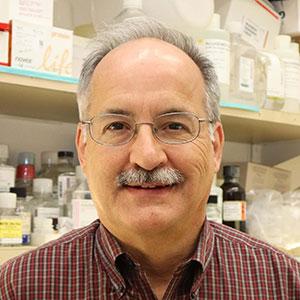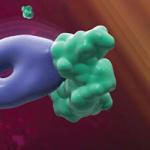
William F. Simonds, M.D.
Senior Investigator
Endocrine Signaling and Oncogenesis Section, Metabolic Diseases Branch
NIDDK
Research Topics
The purpose of my research is to understand the regulation of G protein signaling in brain and endocrine tissue, and to understand the causes of parathyroid tumors, including malignant parathyroid tumors.
Current Research
There are two principal areas of research in my laboratory. The first concentrates on the G protein β5 complex with regulator of G protein signaling (RGS) proteins. G protein β5 is a neuronally expressed, structurally divergent G protein β isoform, which may be functionally specialized. In general, RGS proteins act as GTPase activating proteins targeting Gα subunits and thus can help turn off G protein signalling; recent evidence suggests, however, that certain RGS proteins can also function as signal transducers or effectors in their own right.The observations that Gβ5 forms a tight complex with RGS proteins of the R7 subclass in the brain, and that such complexes are expressed in the cell nucleus and cytoplasm (in addition to the plasma membrane where the complex is anchored by binding to R7 binding protein, an acylated SNARE-like protein), are unexplained by current models of G protein signalling. Mice missing both copies of Gnb5 (the gene that encodes Gβ5) have severe developmental delay, and humans missing both copies of GNB5 have intellectual impairment, speech and language delay, cognitive disability, and cardiac arrhythmia (see link here). We are seeking to better understand the function of the Gβ5/ R7-RGS/R7BP protein complex in the nervous system. Our current work focuses on human and mouse phenotypes associated with GNB5 heterozygosity (GNB5 +/-), and understanding phenotypes associated with conditional Gnb5 knockout in mice.
The other area of research aims to understand the pathogenesis and clinical spectrum of familial isolated hyperparathyroidism, parathyroid cancer, and the hyperparathyroidism-jaw tumor syndrome (HPT-JT). HPT-JT is a familial syndrome of HPT with autosomal dominant transmission and high but incomplete and variable penetrance. Some 20 percent of all affected by HPT-JT have parathyroid cancer, and nearly 20 percent of adult cases appear to be silent carriers. The trait links to the CDC73/HRPT2 locus at 1q25-q31. CDC73/HRPT2 is a widely expressed, evolutionarily conserved gene encoding parafibromin, a predominantly nuclear protein of 531 amino acids. Parafibromin is a component of the evolutionarily conserved PAF1 transcriptional regulatory complex. CDC73/HRPT2 is a tumor-suppressor gene, the inactivation of which is directly involved in predisposition to HPT-JT and parathyroid cancer. Current studies employ model systems and purified recombinant proteins to explore the key molecular mechanisms by which loss of parafibromin function promotes neoplasia.
Applying our Research
This research may help in the diagnosis and therapy of benign and malignant parathyroid tumors, and perhaps other types of tumors. Better understanding of G protein-regulated signaling in brain and hormonal tissue may allow the identification of targets for therapeutic agents to selectively enhance or inhibit neuronal or hormonal signaling.
Need for Further Study
Further research is required to explore other tumors or malignancies that might be related to inactivation of the CDC73/HRPT2 gene.
Biography
- Fellowship, Inter-Institute Endocrine Training Program, 1991
- Senior Staff Fellow, Molecular Pathophysiology Branch, National Institute of Diabetes and Digestive and Kidney Diseases, 1989
- Residency, V.A.-Georgetown Program in Internal Medicine, 1987
- Medical Staff Fellow, Laboratory of Molecular Biology, National Institute of Mental Health, 1985
- Pharmacology Research Associate, National Institute of General Medical Sciences, 1984
- M.D., University of Pittsburgh School of Medicine, 1981
- B.S., Physics, University of Pittsburgh College of Arts and Sciences, 1975
Selected Publications
- Jha S, Simonds WF. Molecular and Clinical Spectrum of Primary Hyperparathyroidism. Endocr Rev. 2023;44(5):779-818.
- Li Y, Zhang J, Adikaram PR, Welch J, Guan B, Weinstein LS, Chen H, Simonds WF. Genotype of CDC73 germline mutation determines risk of parathyroid cancer. Endocr Relat Cancer. 2020;27(9):483-494.
- Pandey M, Zhang JH, Adikaram PR, Kittock C, Lue N, Awe A, Degner K, Jacob N, Staples J, Thomas R, Kohnen AB, Ganesan S, Kabat J, Chen CK, Simonds WF. Specific regulation of mechanical nociception by Gβ5 involves GABA-B receptors. JCI Insight. 2023;8(13).
- Zhang J, Chen W, Chen G, Flannick J, Fikse E, Smerin G, Degner K, Yang Y, Xu C, Consortium AMP-T2D-GENES, Li Y, Hanover JA, Simonds WF. Ancestry-specific high-risk gene variant profiling unmasks diabetes-associated genes. Hum Mol Genet. 2024;33(8):655-666.
- Zhang J, Pandey M, Awe A, Lue N, Kittock C, Fikse E, Degner K, Staples J, Mokhasi N, Chen W, Yang Y, Adikaram P, Jacob N, Greenfest-Allen E, Thomas R, Bomeny L, Zhang Y, Petros TJ, Wang X, Li Y, Simonds WF. The association of GNB5 with Alzheimer disease revealed by genomic analysis restricted to variants impacting gene function. Am J Hum Genet. 2024;111(3):473-486.
Related Scientific Focus Areas



Molecular Biology and Biochemistry
View additional Principal Investigators in Molecular Biology and Biochemistry


This page was last updated on Thursday, August 7, 2025